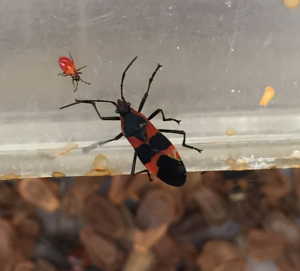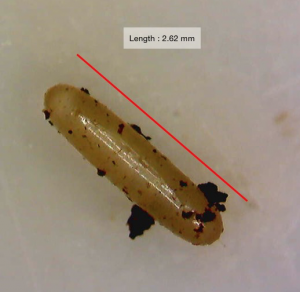How and Where Insects Live
a. Ecology and life cycle
Insects are incredibly important due to their large biomass and making up more than half of the world’s discovered species. This means that their ecology is very important with regards to the environment and how they interact with it. Insects are able to inhabit most biomes and can be found on every continent in the world. Insects often act as pollinators; bumblebees can detect the presence of the atmospheric electricity on nearby flowers, from which they can determine if another bee has pollinated that flower already (Clarke et. al, 2013). Many insects consume large amounts of leaf litter, rotting wood, and feces, making them invaluable for waste reduction. Some insects, such as the Dung Beetle, not only eat feces but also lay their eggs in it. The ability to find a home in feces might not sound appealing to us but it is this knack for surviving anywhere and everywhere that has made insects so evolutionarily successful. Insects also have a very important relationship with humans. We compete with insects for food, as insects consume about 10 percent of the food we produce. On average, insects infect one in every six people with a pathogen (Speight et. al, 1999).
Holometabolist insects follow a lifecycle of egg to larvae to pupae to adult, while hemimetabolist insects develop from an egg to a nymph to adult. One example of hemimetabolism is in the Large Milkweed Bugs.
Large Milkweed Bugs (Oncopeltus fasciatus) exhibit incomplete metamorphosis. The nymph, or younger bug, resembles the fully grown adult only smaller in size.
Insects may pass through seasons in the egg stage; some grasshoppers have been known to pass through summer droughts in the eggshell, becoming dry and shriveled, and resuming development once moistened (Insects, 2015). Some may pass the winter in a diapause, a specific type of dormancy, in their egg and resume after the winter (Insects, 2015).
A zoomed in view of a cricket egg. Once the egg hatches a nymph will emerge that will grow and look similar to an adult cricket, only miniature. They go through incomplete metamorphosis.
After a holometabolist insect hatches, it enters the larval stage. Throughout this stage a gland in the larvae’s brain secretes neotenin, or juvenile hormone, which delays the metamorphosis from larva to pupa, the pupa developing when the amount of neotenin secreted is at a minimum (Insects, 2015). Similarly, neotenin also acts to prevent the metamorphosis from nymph to adult. As long as neotenin is present in the blood the molting cells lay down a larval cuticle, and in the final larval stage, neotenin is no longer produced, allowing the transformation from nymph into adult to begin (Insects, 2015). This allows for evolutionary success because many insects are able to inhabit more than one niche throughout their lives.
b. Throughout evolutionary time up to extant insects
The oldest known insect fossil, Rhyniognatha hirsti, dates back to the Devonian period. In many insect fossils, evidence exists of their feeding behaviors, such as feeding damage on vegetation and wood, giving clues to their habitats and food sources (Grimaldi and Engel, 2005). Insects have always been able to rapidly adapt to environments and resultantly can fit into many niches. Insect evolution is also closely tied to the evolution of plants, with up to 20% of extant insects relying on flowering plants, pollen, or nectar for food (Insect Evolution, 2007). Insects have not left a particularly strong fossil record, because with the exception of in amber, insects are mainly terrestrial and only preserved
in specific conditions on the edge of lakes (Insect Evolution, 2007)
A 24 cm. Madagascar Hissing Cockroach (Gromphadorhina portentosa). Cockroaches are a great example of an insect that has changed relatively little since they first started appearing.
Remarkably, throughout time, insects have changed relatively little in that an entomologist today could likely identify many species buzzing or flitting around in the Jurassic period. Certainly it is millions of years of success that have prompted many to refer to our age as the age of the insects (Insect Evolution, 2007).
Extant Diversity
a. Abundance and Distribution
Due to the overwhelming success of hexapods in an evolutionary sense, extant or living hexapod abundance is astronomically high. Their high reproductive rates combined with their high variety make them present in extremely high numbers that are almost too large to comprehend. Some studies have shown that in one square yard of soil, up to 2,000 different insects can be found. This means that in just one acre there can be about 4 million different insects. Not only that, but hexapods have adapted to even the most extreme environments that range from deserts to the coldest mountains (Insect, 2015). One member of this extant group is the Australian Stick Insect, a bug that is extremely well camouflaged in its natural environment.
A female Australian Stick Insect (Extatosoma tiaratum) hanging from a small branch. The unique outer layer of the body serves to camouflage the insect.

A zoomed out view of the Australian Stick Insects hanging from small tree branches.
Another extant member is the Praying Mantis, an insect that exhibits many of the defining traits of the subphylum hexapoda.
http://youtu.be/MC3inhf3CL4
A praying mantis (Mantodea burmeister) shows off his mouth parts and movement of his compound eyes.
The subphylum hexapoda can be broken down into various clades. First, there are the basic insects known as Class Insecta. This group makes up most of the winged insects that have been studied. According to Dr. Terry Erwin, an entomologist at the Smithsonian museum, this class may make up nearly 90% of all documented species on the planet (Erwin, 1982). Global populations of extant insects are estimated to range from 4 to 6 million different species (Novotney et al., 2002). Members of Class Insecta have also been found to be very adaptable, as shown by the fact that they are found in nearly every freshwater or terrestrial habitat. Some members have even found to be living in marine environments, though this habitat is primarily found to be home to crustaceans (Myers, 2001). There are also 3 groups of wingless insects or Class Entognatha: Collembola, Diplura, and Protura. Collembola, or springtails commonly, are the largest group and can be found essentially anywhere where soil or soil related habitats are found (Ponge, 1993). Populations of over 750 million individuals have even been found in certain grassland regions (Collembola, 2009). The groups Diplura and Protura are still abundant, but not nearly at the scale of Class Insecta. According to Dr. John Meyer, Diplura have around 800 species recognized and Protura have around 500 species recognized. Diplura are also common in grassy areas, but due to their small size they can sometimes be overlooked, meaning species estimates might be lower than reality (Diplura, 2009). Protura are less commonly found and can usually be associated with soil habitats that are damp or moldy (Protura, 2009).
b. Economic Importance
Hexapod insects can have a profound impact when it comes to the human economy. One of their biggest impacts come from natural resources. Insects can be used as a food source or can help produce other products. These products include can includes dyes and waxes, but the two primary products used by humans are honey from honey bees and silk from domesticated silkworms. Honey bees are also important due to their previously mentioned ability to pollinate plants, including human crops. Certain hexapods also have the ability to damage human products, such as wood homes that can be destroyed by insects like termites or furs and skins that can be broken down by insects like tineid moths. Hexapods also have the ability to help crops by assisting in pollination, or competing with humans by devouring said crops due to the herbivorous nature of most insects. Hexapods have a very important role in the medical community, due to the fact that many insects can be vectors, or carriers, for harmful microorganisms that causes diseases. Some of these diseases include malaria, yellow fever, sleeping sickness, and typhoid (Insect, 2015). This makes hexapods and other insects a large focus in biological medicine in order to help prevent such tragic illnesses. On that note, certain insects may also be used to assist in genetics research as well. The common fruit fly (Drosophila melanogaster) is one of these organisms. Due to its short generation time and high rate or reproduction, the fruit fly is considered to be a model organism that is used to study links between genes, evolution of behavior, and development in eukaryotic organisms (Pierce, 2006). Finally, insects can be a food source for human populations. Due to their high protein amounts, some believe that insects may have a high potential to be used in human diets, although diets that include insects are seen as abnormal in some higher developed countries (Gullan, 2005).
Conclusion
As our blog shows, hexapods are more than just the creepy crawly critters you squish under your feet. They have a rich evolutionary history dating back as far as 412 million years ago. Being one of the first insect groups to inhabit terrestrial habitats, hexapods served as a very important role in selecting land based plant life. Hexapods have many interesting characteristics including, the hexapod bauplan, wings, metamorphosis, and highly developed sensory systems.
If you still are not convinced that hexapods are a fascinating taxa of animals, don’t forget they are one of the largest and most diverse groups of animals on the planet. There are over 750,000 species of these guys! Hexapods ensure the success of many ecosystems, and we benefit from a lot of the ecological work they do. If you have ever stopped to admire a beautiful flower, chances are you have a hexapod to thank. Don’t worry if it is still hard for you to see insects as friendly little helpers, but we hope this blog gives you the insight to appreciate how amazing and important they are for our planet.
Works Cited
Clarke, D.; Whitney, H.; Sutton, G.; Robert, D. (2013). “Detection and Learning of Floral Electric Fields by Bumblebees”. Science 340 (6128): 66–9.
Erwin, Terry L. (1982). “Tropical forests: their richness in Coleoptera and other arthropod species”. Coleopt. Bull. 36: 74–75
Grimaldi, David; Engel, Michael S. (2005). Evolution of the Insects. Cambridge University Press. ISBN 0-521-82149-5
Gullan, P.J.; Cranston, P.S. (2005). The Insects: An Outline of Entomology (3 ed.). Oxford: Blackwell Publishing.
Insect. (2015). In Encyclopædia Britannica.
“Insect Evolution”. Virtual Fossil Museum. 2007.
Meyer, John R. (2009). “Collembola”. North Carolina State University.
Meyer, John R. (2009). “Diplura”. North Carolina State University.
Meyer, John R. (2009). “Protura”. North Carolina State University.
Myers, P. 2001. “Insecta” (On-line), Animal Diversity Web. Accessed April 20, 2015 at http://animaldiversity.org/accounts/Insecta/
Novotny, V., Basset, Y., Miller, S. E., Weiblen, G. D., Bremer, B., Cizek, L., & Drozd, P. (January 01, 2002). Low host specificity of herbivorous insects in a tropical forest. Nature, 416, 6883, 841-4.
Pierce, B.A. (2006). Genetics: A Conceptual Approach (2nd ed.). New York: W.H. Freeman and Company. p. 87.
Ponge, Jean-François (1993). “Biocenoses of Collembola in atlantic temperate grass-woodland ecosystems” (PDF). Pedobiologia 37 (4): 223–244.
Speight, Martin R.; Hunter, Mark D.; Watt, Allan D. (1999). Ecology of insects: concepts and applications (4(Illustrated) ed.). Wiley-Blackwell. p. 350.






